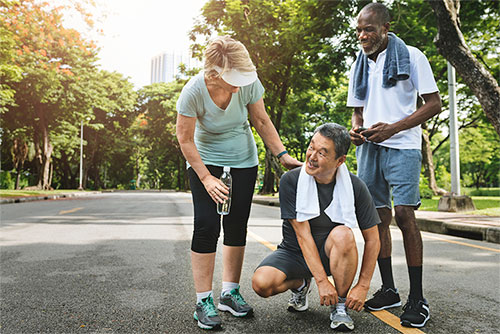
The goal of knee replacement surgery is to allow you to return to your everyday activities without pain as quickly as possible. Yet fear of damaging your new knee might keep you from being active. However, after you have completed physical therapy, your doctor will recommend you resume low impactexercise at home because of the positive effects of muscle strengthening, joint flexibility, and general health benefits that it provides. Here are a few examples of low impact sports and activities that are safe for your new knee:
- Walking. Walking is one of the best exercises you can do after knee replacement. This simple and easy exercise helps strengthen your knee and the muscles around it while also helping you to improve circulation, burn calories, and reduce your risk of heart disease. When you first start walking after surgery you will want to start slow and gradually increase your distance and speed as your knee becomes stronger.
- Swimming. Swimming is another excellent choice because it allows you to exercise your whole body without putting pressure on your joints. You can often begin swimming soon after your surgical wound has healed. Check with your doctor before getting into the pool.
- Cycling. Cycling is a great activity that works the muscles in your legs helping to strength your knee without stressing your joint. Your doctor might recommend you start by pedaling backwards on a stationary bike and build up to riding an actual bike. Riding on a flat surface is recommended to help protect your knee.
- Rowing. Rowing is a full body workout that is gentle on your joints. It can help tone muscles and increase your endurance without putting lots of pressure on your knee.
- Yoga. Yoga is a good activity to help prevent stiffness by gently stretching and increasing flexibility in your knee. Just be sure to keep your knees aligned with your hips and ankles and avoid twisting movements. Let your instructor know about your previous knee surgery so they can help determine which stretches are right for you.
- Golf. Golf is a low impact sport that you can enjoy even after a knee replacement. Be sure to warm up well before playing. Start with short shots such as chipping and putting. Then move to longer shots. Try to use a more upright stance to limit the amount of bending in your knee and gradually increase your swings, being careful to avoid causing pain or swelling. You will want to use a golf cart initially, and then progress to walking the course. If you wear shoes with spikes, make sure they are soft spikes that will not get caught in the ground.
- Tennis. Tennis can also be a low impact sport. When you first return to the court, playing doubles is preferred. Having a partner will decrease the area you will need to cover which will be less demanding on your knee. Clay courts also will put less stress on your knee because they are softer and slower than other courts. This will reduce the impact to your knee as well as give you more time to prepare for each stroke. Always use proper body mechanics while playing. Remember your limitations. Do not try to push your new knee by making fast cutting maneuvers or by stretching for a ball beyond your reach.
A knee replacement can give you a new lease on life, allowing you to return to activities that you had previously given up because of pain. After surgery, be sure to work with your doctor to find the right level of activity for you at each stage of recovery.
For all appointments and inquiries, please call (541) 622-8900 or click here to request an appointment online.
Dr. Yaser A. Metwally is board-certified by both the American Board of Orthopedic Surgery and the Royal College of Surgeons of Canada. He received his fellowship of Reconstructive Surgery from the Mayo Clinic in Rochester, Minnesota and specializes in hip and knee replacement surgery.




 Book an Appointment
Book an Appointment
 Patient Portal
Patient Portal
